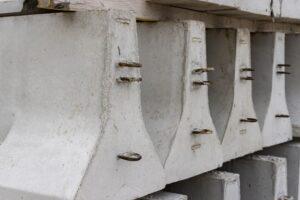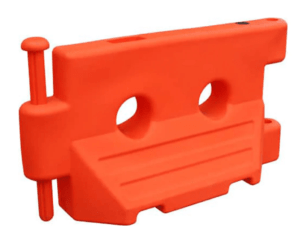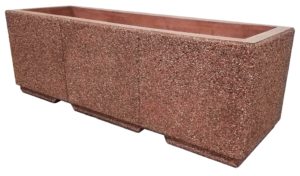Weighing in at 400-500 lbs per linear foot, concrete barriers can be challenging to offload from a flatbed truck, reposition, or set in place on unpaved material. We’re going to explore the best ways to move these barriers safely and efficiently.
Different Ways to Move Your Concrete Barriers
Moving Concrete Barriers with a Barrier Lift
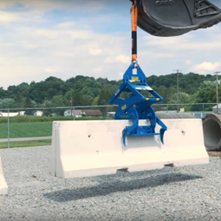
The proper way to move concrete barriers is to use a barrier lift to clamp down on the top. This method
ensures safety and reduces the chance of damage to the barrier. Barrier lifts come in different sizes and types, and it’s important to choose the right one for the job.
For more information or to get help determining which barrier lift is right for you, reach out to our team of experts at 48 Barriers.
Moving Concrete Barriers with a Skid Steer
If a barrier lift is not available, a skid steer is the next best option. However, this method requires caution and skill to avoid damaging the barrier or the machine.
Make sure to use a skid steer with a weight capacity that exceeds the weight of the barrier. Use attachments such as forks or clamps to securely lift and move the barrier.
Using a Forklift
Although some concrete barriers have forklift slots or scuppers on the bottom, it’s not always the best way to move them. The slots are primarily designed for drainage while lining a roadway or highway.
Moving barriers with a forklift can cause damage and compromise the integrity of the product. If a forklift is the only option, make sure to lift the barrier from the top instead of the bottom to avoid chipping or cracking.
Using a Zipper Truck
A zipper truck, also known as a barrier transfer machine, is another option for moving concrete barriers. These machines are designed to move concrete barriers quickly and efficiently by transferring them from one side of the road to the other. They are typically used in situations where traffic patterns need to be changed temporarily, such as during construction or road maintenance projects.
The zipper truck works by straddling the existing barrier with its wheels. It then uses a series of arms and rollers to lift the barrier and move it to the other side of the truck. Once in place, the barrier is lowered back onto the ground, creating a new traffic pattern.
One advantage of using a zipper truck is that it can move multiple barriers at once, which can save time and reduce the need for additional equipment and labor. However, they are typically only used for larger-scale projects due to their size and cost. Additionally, they may not be suitable for all terrain types, so it’s important to evaluate the site before deciding to use a zipper truck.
Tips for Safely Moving Your Concrete Barriers
Handle with Care
Concrete barriers are a durable product, but they can still sustain damage if mishandled. When moving barriers, take care to avoid dropping or dragging them, which can cause chips or cracks.
Be sure to use proper lifting techniques, such as keeping the load close to the body and using the legs to lift instead of the back.
 Consider the Terrain
Consider the Terrain
When moving one of our barriers, it’s important to consider the terrain where they will be placed. If the ground is uneven or sloped, it can make it difficult to move the barriers safely.
Consider using equipment such as a bulldozer or excavator to level the ground before placing the barriers. This can help ensure that the barriers are secure and stable once they are in place.
Plan Ahead
Moving concrete barriers can be a time-consuming and labor-intensive process. To save time and reduce the risk of damage, it’s important to plan ahead.
Before moving the barriers, make sure to measure the space where they will be placed and plan the route for transportation. This can help ensure that the barriers are moved efficiently and safely.
Storing Your Concrete Barriers
When not in use, store concrete barriers properly to prevent damage and prolong their lifespan. Keep the barriers in a dry and secure location, such as a warehouse or storage yard.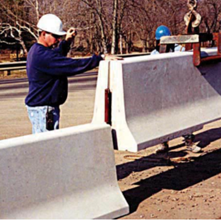
Make sure to stack them properly and use proper lifting techniques when moving them.
Moving concrete barriers requires careful planning and consideration to ensure safety and avoid damage.
Whether using a barrier lift, skid steer, or other equipment, follow proper lifting techniques and use personal protective equipment.
Planning ahead and following local regulations can also help ensure a successful project. By taking these steps, you can move concrete barriers safely and efficiently to provide protection and safety in a variety of settings.
Contact 48 Barriers for All Your Concrete Barrier Needs!
48 Barriers offers a variety of concrete barriers of multiple types and applications. Our solutions are multi-functional and cost-effective. Contact us to discover options available to your organization today!


